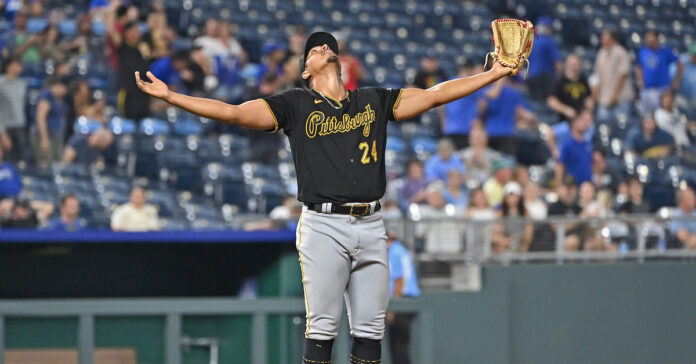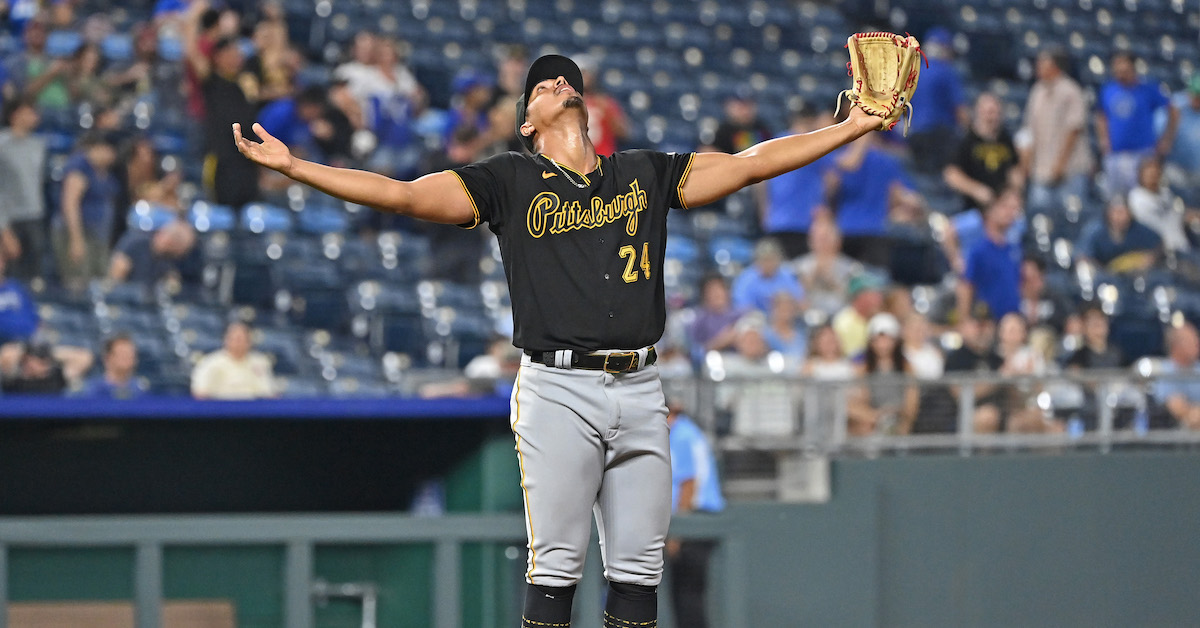
Johan Oviedo has a fastball problem. According to Baseball Savant, the Pittsburgh right-hander’s four-seamer has been worth -9.1 runs this season, making it the 26th-least valuable four-seamer and 49th-least valuable pitch in all of baseball. That’s what happens when a pitch has an 18.1% whiff rate and a 47% hard-hit rate. Luckily, Oviedo’s slider and curveball have been worth a combined 16 runs. That makes his breaking stuff the ninth-most valuable in all of baseball.
If you find yourself screaming at your computer that Oviedo should probably throw his curveball and slider more, guess who agrees with you? Johan Oviedo. Across six starts in April, Oviedo threw his breaking balls 63.5% of the time. Only one player, Hunter Brown, ran a higher breaking ball rate in April while throwing half as many pitches as Oviedo did. But now that you’ve stopped screaming at your computer, I need to tell you that Johan Oviedo disagrees with you too.
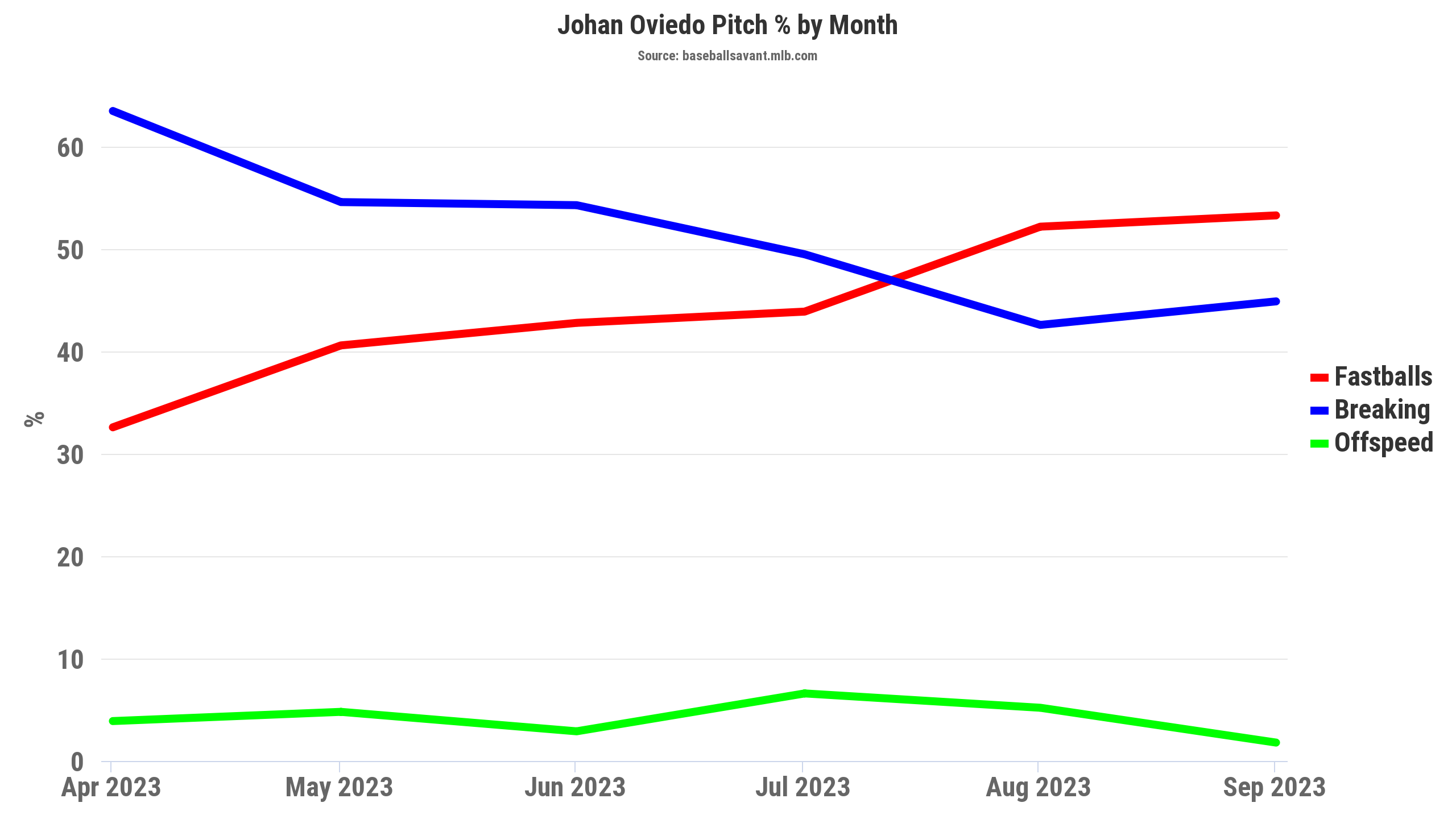
Oviedo’s breaking ball percentage has been falling for most of the season, and it’s settled in the low 40s. That’s right, it’s time to scream again. Why has Oviedo gone back to leading with his worst pitch instead of his best pitches?
Let’s start in 2020. That’s when Oviedo got his first taste of the big leagues, and that’s when Ben Clemens identified him as a candidate to follow in the footsteps of Corbin Burnes, replacing a lifeless four-seamer with a sinker that might actually sink, and maybe even a cutter:
Like Burnes, he has multiple plus secondaries and a fastball with plus velocity but less-than-ideal movement. His slider (which Eric Longenhagen gave a future 60) and curveball both did a good job inducing whiffs in a limited sample size. The slider also got a good amount of grounders, making it easily his best pitch.
His fastball, on the other hand, didn’t turn many heads. It was flat, in the fourth percentile for vertical movement, and suffered from a combination of low spin rate (2,277 rpm at 94.8 mph) and mostly gyroscopic spin. In fact, his 53.1% active spin percentage was even lower than Burnes’ 2019 campaign.
Now we fast-forward to 2022. Oviedo’s pitch mix has not changed. He still throws that four-seamer, along with a great slider, a pretty good curve, and a forgettable changeup. The Cardinals called him up from Triple-A in June, and after a solid first start, he ran a 2.66 ERA and 3.56 FIP over 13 relief appearances.
Next, the Cardinals shipped Oviedo to Pittsburgh, turning those two good months into a shiny new(ish) José Quintana. Pittsburgh sent Oviedo to Triple-A Indianapolis for a month to stretch out as a starter, and he ran a 3.23 ERA and 3.47 FIP over seven starts in his September call-up.
Over the offseason, it turned out that somebody in Pittsburgh read FanGraphs.com, as Oviedo came into spring training with a new sinker. “The Pirates have transformed into Sinker University,” reads the lede, “and Johan Oviedo just enrolled as the newest student.”
So that was the plan heading into this season. Oviedo would try to earn a rotation spot by working in a sinker to take the pressure off his flat four-seamer. But at some point in mid-March, he tabled the sinker in order to work on his four-seamer and changeup. It sounds like the sinker wasn’t ready yet, and while it was expected to make an entrance eventually, he wanted to work on the pitches he already had. “I’m definitely going to need that pitch, especially when I need a groundball,” he said at the time. “The season is almost here and I need to perform.”
Then spring training ended and the season started, and Oviedo was out there throwing 63.5% breaking balls. Both the slider and the curve added roughly 2.5 mph of velocity. As Michael Ajeto noted at the time, Oviedo leading with his slider wasn’t necessarily new. The new wrinkle was bumping up his curveball usage to take the place of his four-seamer and tunneling the curveball off the four-seamer. After throwing his curve roughly 11% of the time over the past three seasons, he threw it 21.4% of the time in April.
And then, as quickly as the experiment began, it ended.
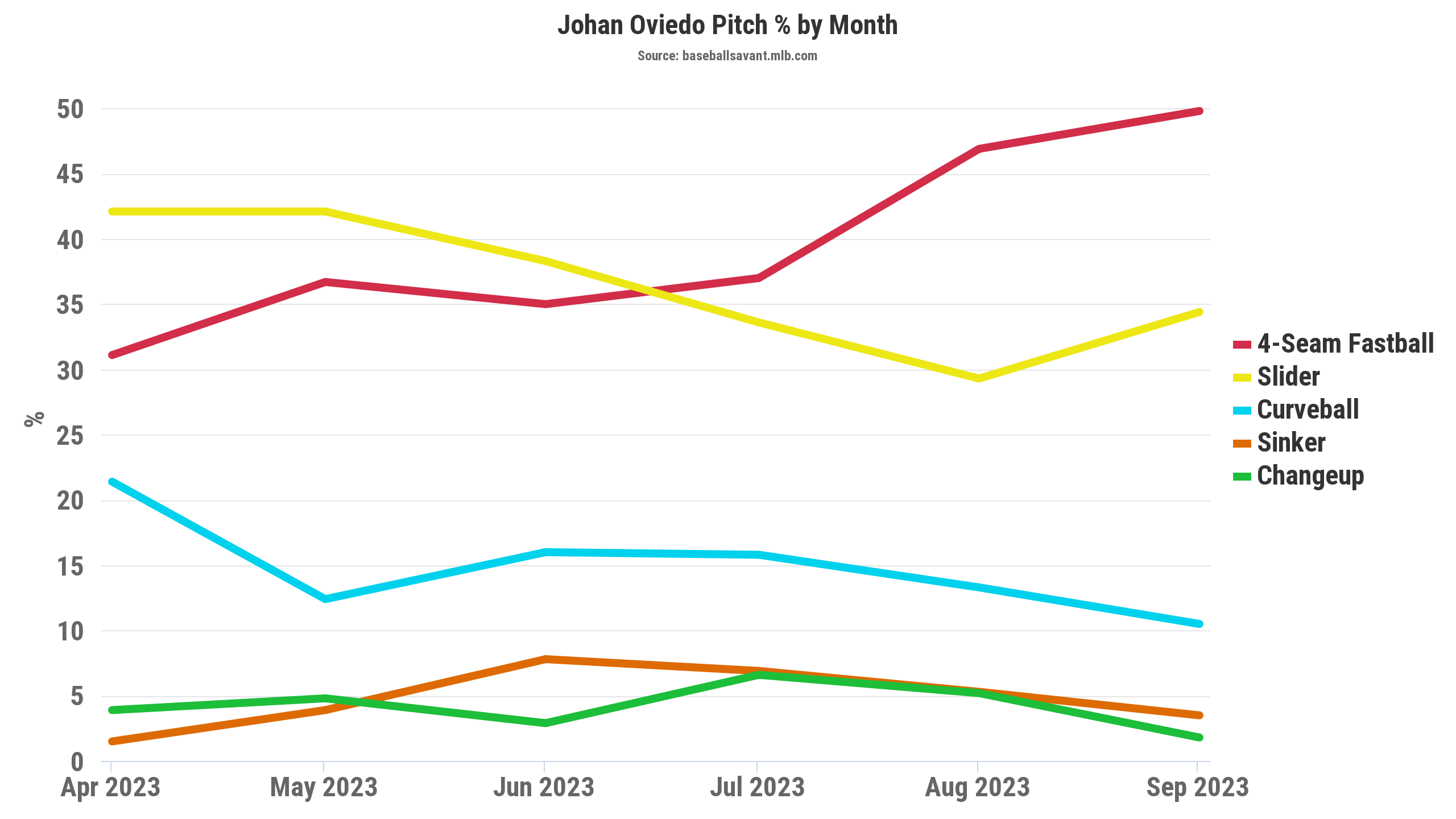
Oviedo’s curveball use is back down to its historic levels, and his four-seamer overtook his slider as his primary pitch some time around midseason. Here’s how that has turned out:
Johan Oviedo’s 2023 Splits
| Half | ERA | RA9 | FIP | xFIP | wOBA | xwOBA |
|---|---|---|---|---|---|---|
| 1st Half | 4.75 | 5.11 | 4.17 | 4.67 | .323 | .333 |
| 2nd Half | 3.53 | 3.80 | 4.68 | 5.01 | .299 | .315 |
Well that’s not confusing at all. Oviedo has performed better during the second half, but FIP and xFIP think he was better during the first half, and xWOBA doesn’t see that big a difference between the two. Let’s dig a little deeper:
Johan Oviedo’s Other 2023 Splits
| Half | BABIP | LOB% | K-BB% | EV | IFFB% |
|---|---|---|---|---|---|
| 1st Half | .300 | 67.7% | 10.5% | 88.6 | 4.6% |
| 2nd Half | .238 | 77.0% | 8.9% | 87.5 | 16.2% |
Oviedo is walking more batters and striking out fewer, which certainly explains why FIP isn’t convinced. It’s also exactly what you’d expect from a guy who’s throwing fewer of the pitches that actually get whiffs. He’s also seen a jump in strand rate and a drop in BABIP, indicators that a pitcher has been the beneficiary of some luck. But at the same time, his exit velocity is down, and his popup rate has increased by way more than enough to explain the drop in BABIP. Is the four-seamer responsible for his increased popup rate?
Johan Oviedo’s Popup Rate Splits
| Half | Four-Seamer | Slider | Curve | Sinker | Changeup |
|---|---|---|---|---|---|
| First Half | 3.7 | 3.9 | 8.3 | 5.3 | 0 |
| Second Half | 8.8 | 19.6 | 17.6 | 0 | 0 |
SOURCE: Baseball Savant
Not really. Most of the popups have come on breaking balls. But here’s the thing: Oviedo’s four-seamer has performed significantly better in the second half. I told you earlier that it’s been worth -9.1 runs this season, but let me break that down. In the first half, it was worth -7.6, and in the second half it’s been worth -1.5. What accounts for the difference? That popup rate helped, as did an increase of roughly two percentage points in strike rate and whiff rate. Lastly, it doesn’t hurt that the four-seamer’s wOBAcon went from 28 points worse than its xwOBAcon in the first half to 56 points better in the second half.
The four-seamer’s other stats are pretty similar from the first half to the second. It has lost 1.1 mph, and Stuff+ thinks it went from an 85 to a 79. Even if we can’t say for certain that the four-seamer’s improvement is real and sustainable, it’s hard to fault Oviedo for sticking with it when it’s working.
And that’s where I’m going to leave you. I’m out of answers, friends. The problem is that there are so many things going on. Oviedo has changed so much that there’s no such thing as a control variable. He started incorporating the sinker in May but hasn’t used it all that much and has been moving even further away from it lately. In fact, he has yet to throw a sinker to a lefty this month. He’s also de-emphasized his changeup of late, and his release point has been drifting to the left all season:
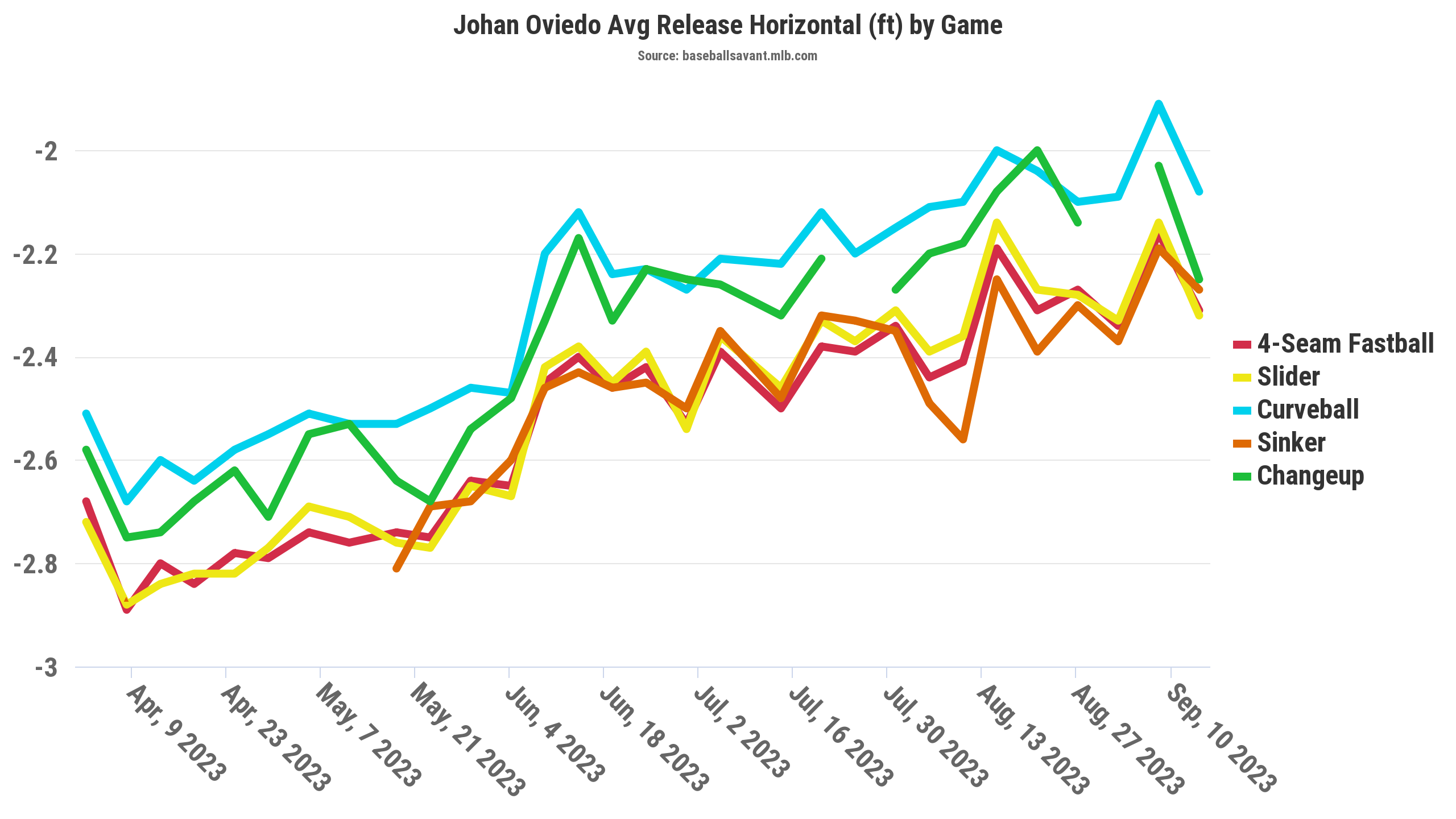
Neither his vertical release point nor his extension have changed much, which means that Oviedo has achieved this new release point the old-fashioned way: scooching over on the rubber. I’ve highlighted the rubber so it’s easier to see the difference. His current release point is on the left, and his April release point is on the right:
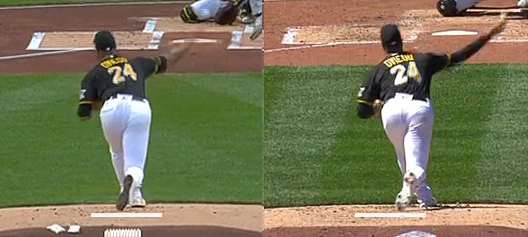
I don’t know whether this has to do with comfort or whether it’s a conscious attempt to tamp down an unruly platoon split. It has taken place so gradually and for so long that part of me wonders whether Oviedo even knows it’s happening.
Despite the many adjustments Oviedo has made, maybe there’s a simple explanation for performance this season. He was good last year pitching mostly out of the bullpen, but this year as a starter, his velocity is down a tick, and his results have taken a step back. We’ve certainly heard that story before. But there’s also so much to explore.
Oviedo is 25, and after seven years as a professional, there are still several things I’d love to see him try. He only spent a month going all-in on his slider-curveball combo, and it seemed to come at a time when he experienced some bad batted ball luck. Maybe it’s worth another shot. He hasn’t come close to fully committing to the sinker and seeing what happens when he makes it his primary fastball. So far, Stuff+ has it at 101, a significant step up from the four-seamer at 83. Pairing his breaking balls with an average fastball would be a huge upgrade. And unlike Burnes (and approximately every pitcher in baseball), Oviedo has yet to try adding a cutter. Maybe someone could teach him a changeup that better suits his mechanics.
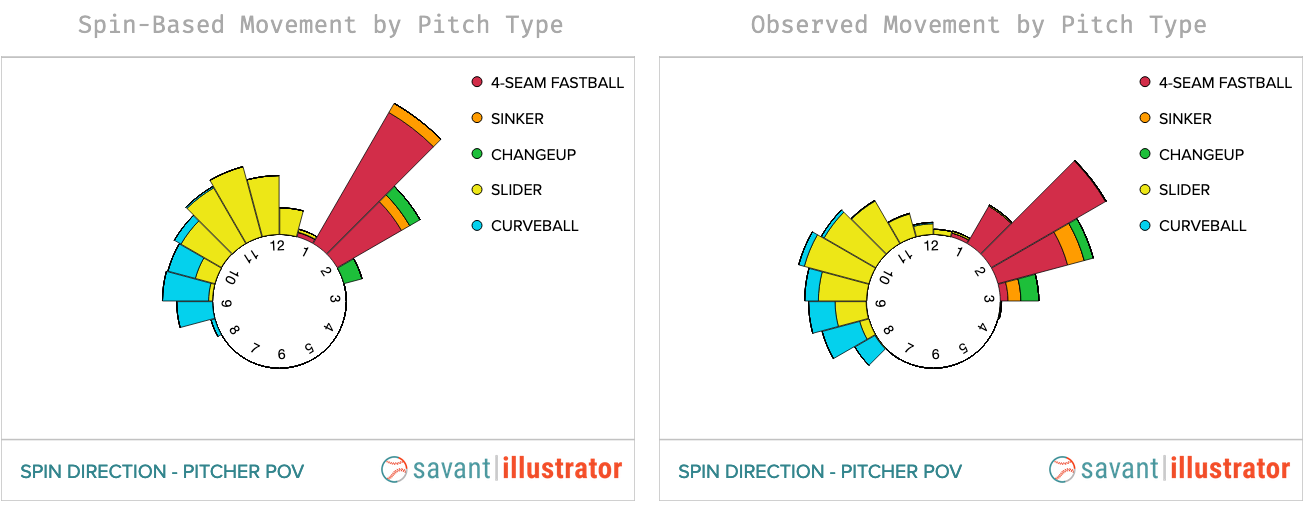
Or Oviedo could stop tinkering with his repertoire and focus on his command. He has a tendency to miss to his arm side, which can cause problems for a pitcher if — just to pick an example out of thin air — they happen to throw three consecutive fastballs in toward Ronald Acuña Jr.’s ribs. If all he did was figure out how to spot his fastball and changeup better, he’d be a completely new pitcher.
Maybe Oviedo will head back for another semester at Sinker University this offseason, or maybe he’ll try something else entirely. Whatever it is, it might be time for him to pick a path and stick to it. It’s awfully hard to succeed while making such big mid-season adjustments. Regardless, I’ll be excited to see which Oviedo we see in 2024.

